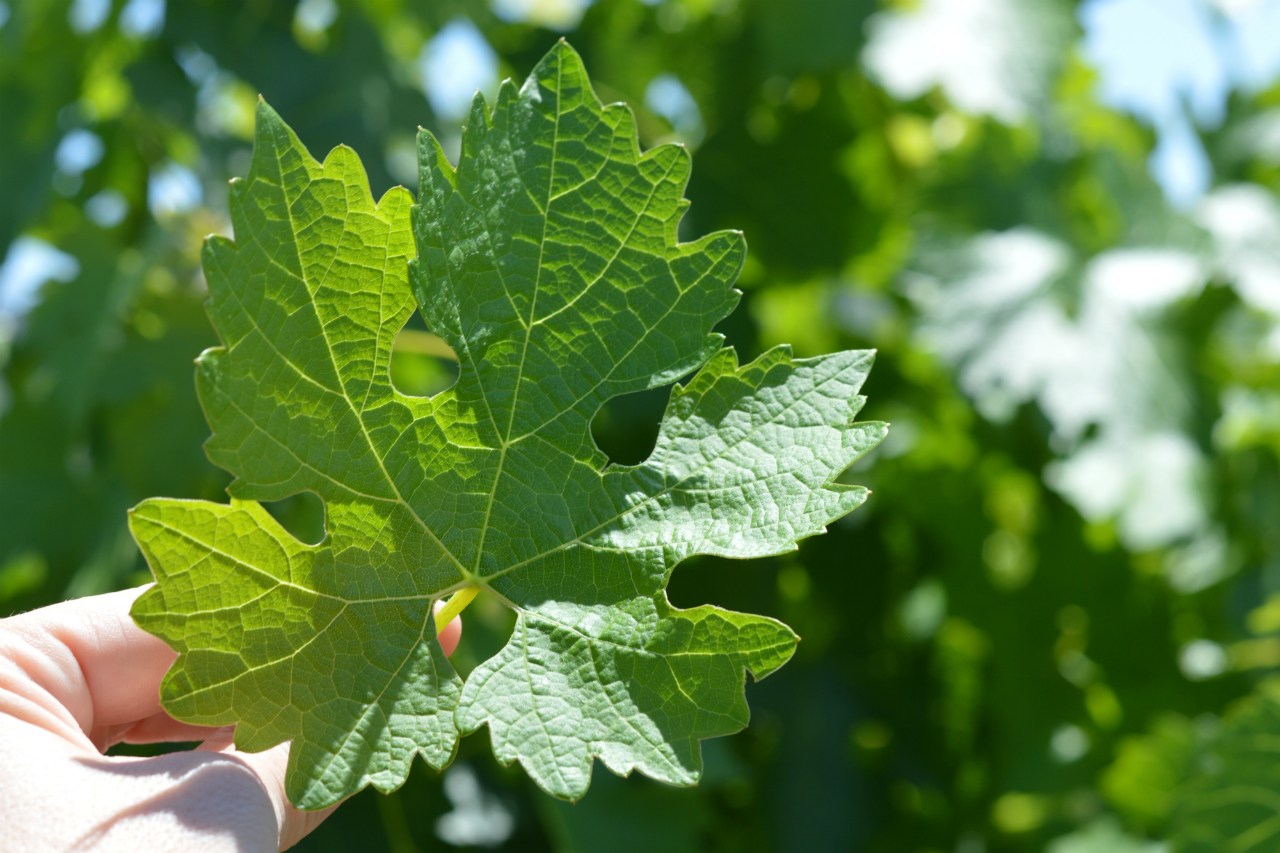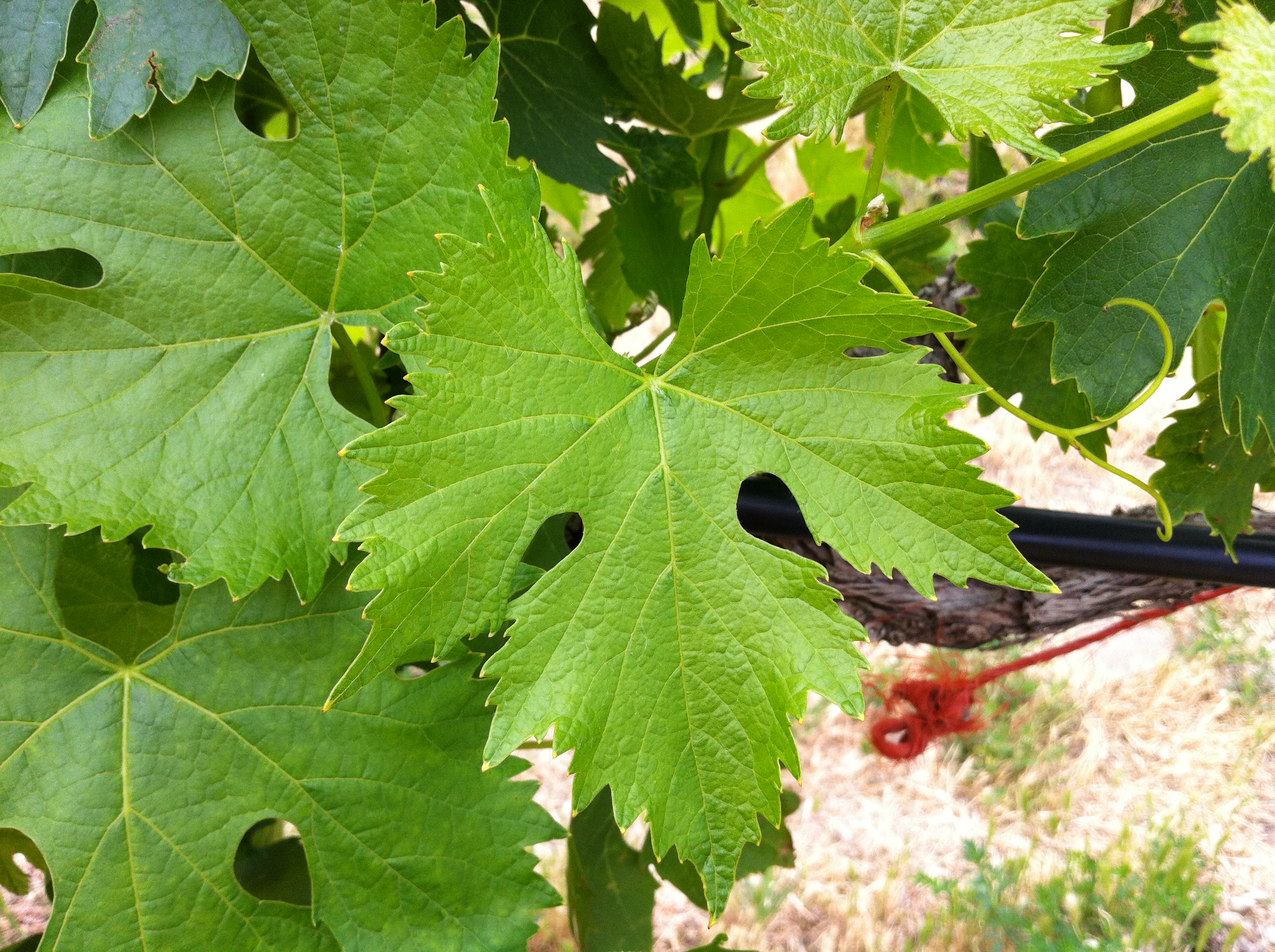Blog
Ampelography Basics...Worth the Challenge!
08/28/2017
It’s no secret that the newly installed educational vineyard is my favorite area of the Al Lago Winery property. I begin most of my work days outside with the new vines, evaluating their progress and tending to their irrigation. Due to the elevated summer temperatures, I’ve had to keep a closer eye on them for any visible signs of stress. The leaves of a vine can “tell” you a lot about that vine -- the varietal of the vine, the health of the vine, its access to water, etc. Recently, while examining the leaves of each new shoot for discoloration, I began to take more notice of the small differences in their shape and surface texture. There are over 10,000 known grapevine varieties worldwide. Although they may have a similar appearance, each has a specific combination of physical qualities unique to its type. With experience these differences become easier to spot -- making it possible to identify the varietal by sight alone. This ability -- to look at the unique features of a grape leaf and use them to identify what type of vine it is -- is known as ampelography.
In our last article on terroir, I mentioned that the Al Lago vineyard had a sizable fraction of clay in its soil composition. The terroir of the Al Lago vineyard is a key component to the quality of the wine we make, but it comes with some risks. Clay-rich soils are also the preferred environment of phylloxera (an aphid that "single-handedly" devastated the vineyards of Europe when it was brought over from the Americas). This tiny pest can destroy an entire vineyard in a matter of weeks; however, we now have access to many new vines that have been engineered to resist these grape pests. Each of these new hybrids have subtle physical differences in their leaves that allow you to distinguish them from the original source. Without any lab tests, ampelography is the key to ensure you have the right clone of the vine in the vineyard to manage the risk of this pest. Ampelography is a challenge to master, but learning the basics could make you the most popular person at your next wine-tasting party. So what is there to know and how do you get started? Let's find out!
There are several factors you can consider when you are trying to distinguish one variety of vine from one another, but the physical characteristics of the leaves are perhaps the most useful to the novice ampelographer. In general, grapevine foliage all share a few universal characteristics. They all have a palmate vein arrangement, which means that instead of a central vein down the middle of the leaf, there are three or more veins originating from the same point and fanning out. Think of it as the fingers coming off the palm of your hand, which is why we call it “palmate”. Because of this vein pattern the leaf blade is divided into distinct sections called lobes and the cavities between the lobes are called sinuses. I like to think of sinuses as empty space and lobes as actual plant tissue. The edges of the leaf blade will have varying degrees of serration, also known as toothed margins. The surface of the leaf blade will have a thin waxy layer called a cuticle while the bottom will show the presence of leaf hairs.
I chose two of our varietals and included pictures of their leaves below for comparison; let’s take a look!
Cabernet Sauvignon leaves are very distinct. They are medium in size and characterized by five prominent lobes with deep sinuses. The lobes themselves overlap and since the inner edges of the sinuses are rounded the leavesalmost look like holes have been punched into the tissue. The leaf margins have medium teeth that are slightly rounded while the upper surface of the blade is smooth and a rich green in color. The lower surface has scattered tufts of hair and is a slightly muted green. The sinus area near the leaf stem curves into a characteristic lyre-shape.
with deep sinuses. The lobes themselves overlap and since the inner edges of the sinuses are rounded the leavesalmost look like holes have been punched into the tissue. The leaf margins have medium teeth that are slightly rounded while the upper surface of the blade is smooth and a rich green in color. The lower surface has scattered tufts of hair and is a slightly muted green. The sinus area near the leaf stem curves into a characteristic lyre-shape.
Now compare that to this leaf from a Sangiovese shoot, which we also see in the Al Lago vineyard. They are much larger than those of Cabernet and are divided into three lobes with narrow sinuses. The top lobe has a prominent triangular shape. The teeth on its margin are much smaller and sharper than those of Cabernet. The space at the leaf stem is open and U-shaped, The top surface of Sangiovese leaves are smooth and the lower surface is mostly (but not completely) absent of leaf hairs. The bottom of younger leaves have gold and bronze streaks.
are divided into three lobes with narrow sinuses. The top lobe has a prominent triangular shape. The teeth on its margin are much smaller and sharper than those of Cabernet. The space at the leaf stem is open and U-shaped, The top surface of Sangiovese leaves are smooth and the lower surface is mostly (but not completely) absent of leaf hairs. The bottom of younger leaves have gold and bronze streaks.
I encourage you to compare leaves on your next visit to wine country. It’ll give you a new appreciation for the unique qualities found in each vine and wine. After all vines vary in structure as much as their wines vary in taste.
In our last article on terroir, I mentioned that the Al Lago vineyard had a sizable fraction of clay in its soil composition. The terroir of the Al Lago vineyard is a key component to the quality of the wine we make, but it comes with some risks. Clay-rich soils are also the preferred environment of phylloxera (an aphid that "single-handedly" devastated the vineyards of Europe when it was brought over from the Americas). This tiny pest can destroy an entire vineyard in a matter of weeks; however, we now have access to many new vines that have been engineered to resist these grape pests. Each of these new hybrids have subtle physical differences in their leaves that allow you to distinguish them from the original source. Without any lab tests, ampelography is the key to ensure you have the right clone of the vine in the vineyard to manage the risk of this pest. Ampelography is a challenge to master, but learning the basics could make you the most popular person at your next wine-tasting party. So what is there to know and how do you get started? Let's find out!
There are several factors you can consider when you are trying to distinguish one variety of vine from one another, but the physical characteristics of the leaves are perhaps the most useful to the novice ampelographer. In general, grapevine foliage all share a few universal characteristics. They all have a palmate vein arrangement, which means that instead of a central vein down the middle of the leaf, there are three or more veins originating from the same point and fanning out. Think of it as the fingers coming off the palm of your hand, which is why we call it “palmate”. Because of this vein pattern the leaf blade is divided into distinct sections called lobes and the cavities between the lobes are called sinuses. I like to think of sinuses as empty space and lobes as actual plant tissue. The edges of the leaf blade will have varying degrees of serration, also known as toothed margins. The surface of the leaf blade will have a thin waxy layer called a cuticle while the bottom will show the presence of leaf hairs.
I chose two of our varietals and included pictures of their leaves below for comparison; let’s take a look!
Cabernet Sauvignon leaves are very distinct. They are medium in size and characterized by five prominent lobes
 with deep sinuses. The lobes themselves overlap and since the inner edges of the sinuses are rounded the leavesalmost look like holes have been punched into the tissue. The leaf margins have medium teeth that are slightly rounded while the upper surface of the blade is smooth and a rich green in color. The lower surface has scattered tufts of hair and is a slightly muted green. The sinus area near the leaf stem curves into a characteristic lyre-shape.
with deep sinuses. The lobes themselves overlap and since the inner edges of the sinuses are rounded the leavesalmost look like holes have been punched into the tissue. The leaf margins have medium teeth that are slightly rounded while the upper surface of the blade is smooth and a rich green in color. The lower surface has scattered tufts of hair and is a slightly muted green. The sinus area near the leaf stem curves into a characteristic lyre-shape.Now compare that to this leaf from a Sangiovese shoot, which we also see in the Al Lago vineyard. They are much larger than those of Cabernet and
 are divided into three lobes with narrow sinuses. The top lobe has a prominent triangular shape. The teeth on its margin are much smaller and sharper than those of Cabernet. The space at the leaf stem is open and U-shaped, The top surface of Sangiovese leaves are smooth and the lower surface is mostly (but not completely) absent of leaf hairs. The bottom of younger leaves have gold and bronze streaks.
are divided into three lobes with narrow sinuses. The top lobe has a prominent triangular shape. The teeth on its margin are much smaller and sharper than those of Cabernet. The space at the leaf stem is open and U-shaped, The top surface of Sangiovese leaves are smooth and the lower surface is mostly (but not completely) absent of leaf hairs. The bottom of younger leaves have gold and bronze streaks.I encourage you to compare leaves on your next visit to wine country. It’ll give you a new appreciation for the unique qualities found in each vine and wine. After all vines vary in structure as much as their wines vary in taste.
Post By:
Samantha Mogull
Add a comment
Comments are subject to approval and may not post immediately.

